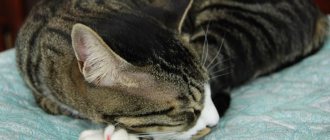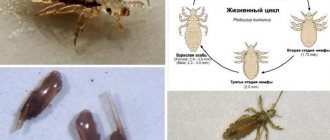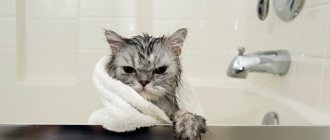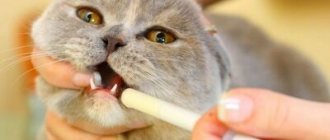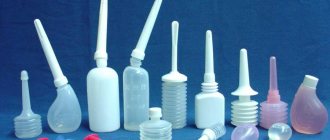Ear scabies, or otherwise known as otodectosis, is a common problem in cats. The disease can occur both internally and externally. The most dangerous is the internal form of the disease. The pathology not only causes discomfort, but is quite dangerous and can lead to hearing loss.
An ear mite looks like an accumulation of dirt in the ear and has an unpleasant odor. The longer the animal is sick, the worse it becomes: the cat gets worried and shakes its head.
Ear mites are not dangerous to humans, but they are contagious to other cats, as well as dogs. At the same time, a person is a carrier of this nuisance from one animal to another. Most often, animals become infected during the warm season.
Causes of ear mites
- The most common infection with ear mites occurs outdoors while walking. Parasites are found everywhere: in attics, basements, in the grass. And since cats are very curious animals, they love to explore all the listed places.
- When pets come into contact with homeless relatives, they are also susceptible to this scourge.
- The rug near the front door can be a breeding ground for various diseases, especially if it is not washed often enough.
Brands of drugs
Pharmacy chlorhexidine can be used to treat wounds. The drug is intended for people, but is also suitable for animals. Rarely causes unwanted reactions. Apply externally, locally.
The “Diamond Eyes” product has been developed especially for cats to treat the visual organs. Chlorhexidine in this drug is the main component. Contains vitamin C and taurine.
Shampoos with chlorhexidine for cats:
- In Pchelodar shampoo the concentration of the active substance is 5%. Suitable for cats, dogs.
- You can use Doctor VIC. The chlorhexidine content of this pet shampoo is 4%.
- To treat cat eyes, you can use Cliny drops.
- A good product from Beaphar Petshop will help if the animal gets injured.
- Citoderm shampoo is recommended by veterinarians. He also received good reviews from owners of cats and dogs.
Life cycle of ear mite development
Stage 1: egg.
One female can lay up to 5 eggs. After four days, the larvae appear.
Stage 2: larva
See also: How dangerous are cats for humans?
The larva actively consumes earwax for food from 3 to 5 days and moults into a nymph within a day.
Stage 2: nymph.
At this stage, the tick lives for about 10 days, then turns into an adult, which in appearance resembles a crab with very developed limbs, about 0.5 mm in size. If the nymph that has turned into an adult tick is female, then it is already fertilized and will soon lay eggs.
Otodectosis: stages of development
Symptoms of mite formation in the ear
- scratching the ears (or one ear);
- inflammation;
- receding hairline;
- coffee-colored flakes in ears;
- scratches near the ears;
- discharge and unpleasant odor;
- bowhead;
- disorientation.
When neglected, the mite penetrates the inner ear and inflammation of the meninges begins.
The main signs of an ear mite are: dirt in the ear.
This can lead to the death of the animal. Signs that the disease has penetrated the inner ear:
- lethargy of the animal;
- convulsions;
- temperature increase.
How to determine that a cat has ear mites and not otitis media or an allergy?
- Ear mites are white, so to examine them you need to take a black sheet or piece of dark fabric.
- Very carefully swab the ear with a cotton swab. Try to take as much of the discharge as possible without damaging the ears.
- Then shake the stick over a dark background.
- View the surface under a magnifying glass. If you can see white dots showing subtle signs of life, then these are ticks. If the dots are not visible, then the animal probably has another disease, but perhaps the ticks are still too small and cannot be seen.
How to use shampoo
The products must be used strictly according to the instructions. Otherwise, it is possible to harm the cat. Do not wash your animal with the product too often. For kittens and pregnant or lactating cats, a reduced dosage may be necessary.
You need to wash your cat when she is calm and relaxed. It is better to do this with an assistant so that the pet does not escape or scratch the owner. It is recommended to take antiseptics with you so that if necessary, you can immediately treat wounds.
The cat is placed in a basin so that the level of liquid reaches its stomach. The water should not be too hot or cold. Otherwise, the animal will experience discomfort. Squeeze the required amount of shampoo onto your hand, lather, distribute over the cat's fur, paying special attention to the affected areas.
Proceed carefully so as not to hurt the cat. Leave for 5 minutes. Then rinse thoroughly with warm water. Wrap the cat in a warm, soft towel. Provide the animal with rest.
Treatment
If your cat is diagnosed with ear mites, then treatment should be prescribed by a veterinarian, depending on the extent of the damage and the severity of the disease.
To save your pet from an unpleasant misfortune, you will need to be patient.
The complex of therapeutic measures includes:
- Getting rid of ear mites.
- Combating complications.
- Relieving symptoms of the disease.
- Restoring the integrity of the skin.
It is important to understand that if the ears remain dirty, then the use of sprays, drops and other treatment agents will be ineffective, so the resulting crusts must be soaked and removed. To do this, use hydrogen peroxide, chlorhexidine or other pharmaceutical products.
Next, antiseptic drugs are instilled into the ears: Otodepine, Amitrazine, Tactic, Amit, Akromectin, etc. To prevent the animal from interfering with this procedure, swaddle it first.
If the cat is very bothered by itching, then otonazole drops can be used between treatment sessions. They will help alleviate the cat's condition.
In addition to treatment with antiseptic drops, it is a good idea to use antifungal ointment. If an animal is sick for a long time, then the appearance of fungus is inevitable.
See also: Worms in cats: causes, symptoms and treatment
In especially severe cases, injections must be used.
If treatment is not started in time, hearing loss and even death are possible.
When otodectosis is accompanied by purulent otitis, the use of antibiotics is necessary. In order to select the necessary antibacterial agents, the doctor takes an antibiotic sensitivity test from the sick animal.
Indications for use
- for washing cats with wounds, injuries, scratches;
- with lichen;
- for fungal infections.
Chlorhexidine in its pure form can be used:
- for treating the ears and eyes of a pet during suppuration;
- with candidiasis;
- for the prevention of sexually transmitted pathologies (gonorrhea, chlamydia, etc.);
- for treating the oral cavity during inflammation and suppuration;
- for allergic lacrimation;
- for preventive purposes to treat the eyes of some breeds, in which, due to anatomical features, purulent lesions of the visual organs are possible;
- with conjunctivitis;
- to remove specks and small foreign objects from the eyes;
- in preparation for the treatment of infectious pathologies;
- with cervical erosion.
Such drugs have an anti-inflammatory effect, destroy pathogenic bacteria, prevent the development of infectious diseases and complications, relieve redness and relieve itching.
The most effective remedy for ear mites. Drops overview
Possible side effects and contraindications to the drugs are indicated in the attached instructions. You can buy them at a pet store or veterinary pharmacy. Consult your veterinarian before use.
Traditional methods of treating ear mites
Folk remedies can be used only at the onset of the disease, as a means of prevention or in combination with the main treatment.
- Drops for the treatment of ear mites can be prepared independently using green tea. For a glass of boiling water, 1 spoon of tea. Let it brew and cool. Place a dropper in your ears every day for 30 days. Treatment with folk remedies takes time, but is more gentle on animals.
- Celandine also has good healing properties. It is necessary to collect its stems and squeeze out the juice. The resulting medicine is instilled 2 times a day.
- Garlic is a good antiseptic. It must be infused in any oil for 24 hours. Instill once a day.
How to wipe a cat's eyes at home? Is it possible to use chlorhexidine?
Eye problems are considered to be quite common in cats. The development of pathologies of the visual organs is often the cause of infectious diseases or foreign bodies entering the eyes. After detecting the first symptoms of blurred vision, suppuration and redness of the pupils, you must immediately rinse the cat’s eyes at home or seek help from a veterinarian.
Clear and grayish discharge from the eyes is considered normal among healthy cats and kittens. In this case, it is enough to sometimes rinse your pet’s eyes with boiled water or chamomile decoction. In some situations, the animal can observe the process of suppuration or the release of excess fluid, which indicates the presence of an inflammatory process.
The following are the reasons for excessive secretion:
- the presence of a bacterial or viral infection, pathogenic fungi or parasites in the body;
- mechanical injury or bruise;
- ingress of a foreign object of insignificant size;
- an allergic reaction of the body to household chemicals, medications or plants.
In almost all situations, you can notice not only the release of fluid, but also the formation of pus. The presence of such symptoms leads to a lack of appetite, the eyes begin to itch, and the cat itself tries to hide in a secluded place. This condition requires specialist intervention.
A cat's eyes secrete a clear fluid that acts as a lubricant. Such secretions soften the friction between the inner surface of the eyelid and the cornea, which avoids injury due to dust and other foreign bodies. As a result, every morning a dark crust forms near the cat’s eye, which is not suppuration, but a natural discharge.
Typically, pus-filled eyes or excessive tear production is a concern for pet owners. According to certain factors, the reason for such a deviation can be determined:
- Yellowish or clear tears may cause dirt, dust, or other foreign bodies to get into the eyes and cause irritation;
- a common cold can cause irritation;
- redness in the affected area indicates that the cat may have accidentally damaged the cornea;
- If a pet constantly covers its eye with its paw, then it is quite possible that there is an infectious pathology.
Pet owners should consider purchasing eye rinses in advance, even if the cat is healthy. After all, such a procedure is a mandatory element of animal care.
You can wash your cat’s eyes yourself using special folk remedies that can be prepared quickly and without any special financial costs:
- Dissolve boric acid powder in an amount of 5 g in 250 ml of boiled water;
- brew 6 g of dried linden in 0.5 liters of boiling water;
- pour 5 g of pharmaceutical elderberry into 100 ml of boiling water;
- Pour several fresh celandine petals with hot water and leave to infuse for 25-30 minutes;
- brew 1 tbsp. l.dried chamomile in a glass of boiling water;
- Black tea.
Black tea is an effective remedy that allows you to wash your eyes an unlimited number of times without harming your health. It should be noted that it is advisable to use yesterday's tea bag.
It is advisable for a healthy kitten to wash its eyes exclusively with the help of folk remedies. The use of pharmaceutical drugs will not bring the desired result, since they are strictly aimed at treating a specific disease, and not at maintaining health.
Any prepared solution must be filtered thoroughly before wiping your pet’s eyes. They should be free of large particles of plants or all kinds of foreign bodies. In addition, the tincture cannot be used hot, so it should first be cooled.
Many veterinarians, when an inflammatory process is detected, advise using Chlorhexidine for first aid. The drug is a reliable antiseptic for hardening and is ideal for any eye diseases. Regular use of the drug will prevent an allergic reaction or conjunctivitis.
Chlorhexidine has an antibacterial effect and is used in the presence of diseases such as herpes or chlamydia. Eye diseases in cats and kittens are often caused by bacteria, so this drug is an indispensable tool for helping pets.
To wash a cat’s eye at home, you need to use a regular cotton pad or gauze pad, which should preferably be thoroughly moistened in the solution, and then wiped from the outer edge of the eyelid to the corners of the eyes. At the end of the procedure, the napkin should be squeezed out until all remaining solution gets into the conjunctival sac.
It is advisable to wipe one eye no more than 3 times until it is clean. Then repeat the steps with the next one. It is recommended to carry out the procedure no more than 2-3 times during the day.
Owners are required to monitor the health of their pets and use appropriate medications at the first detection of redness or discharge. If the inflammatory process does not go away within 2-3 days, then you should immediately seek help from a veterinarian.
Prevention measures
Unfortunately, it is impossible to protect your pet from such a problem as ear mites, but you can reduce the risk of infection by using the following measures:
- When entering the house from the street, dry your feet thoroughly and wash the rug located at the front door more often.
- When you come home, wash your hands first and then pet the animal.
- Take care of your pet's ears and monitor their condition.
- The animal must be provided with proper nutrition.
- If you suspect that something is wrong with your ears, contact your veterinarian immediately.
